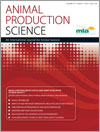Ver ítem
- xmlui.general.dspace_homeCentros e Institutos de InvestigaciónCIA. Centro de Investigaciones de AgroindustriaInstituto de Tecnología de AlimentosArtículos científicosxmlui.ArtifactBrowser.ItemViewer.trail
- Inicio
- Centros e Institutos de Investigación
- CIA. Centro de Investigaciones de Agroindustria
- Instituto de Tecnología de Alimentos
- Artículos científicos
- Ver ítem
Relationship between changes in core body temperature in lambs and post-slaughter muscle glycogen content and dark-cutting
Resumen
Pre-slaughter stress may decrease muscle glycogen content, a key element for a suitable low ultimate pH and prevention of dark-cutting meat. Body temperature monitoring is a tool used in research on animal stress, as an indicator of stress events. Possible relationships between body temperature of sheep and post-mortem muscle glycogen were investigated in this study. Body temperature was measured with intravaginal loggers inserted into each animal at 3
[ver mas...]
Pre-slaughter stress may decrease muscle glycogen content, a key element for a suitable low ultimate pH and prevention of dark-cutting meat. Body temperature monitoring is a tool used in research on animal stress, as an indicator of stress events. Possible relationships between body temperature of sheep and post-mortem muscle glycogen were investigated in this study. Body temperature was measured with intravaginal loggers inserted into each animal at 3 days pre-slaughter, to record body temperature every 3 min over a period of 3 days. Blood samples were collected from each animal at exsanguination for measurement of glucose and lactic acid concentrations. The muscle content of glycogen and lactic acid were determined in samples of M. longissimus collected at the level of the 13th rib, at 1 h post-slaughter. A plot of body temperature versus time showed a rise in body temperature from all animals during events such as mustering, loading onto the truck, unloading at the abattoir, during pre-slaughter handling and at slaughter. Pearson’s correlation coefficients were determined between (1) the main temperature increments occurring between farm and slaughter; and (2) post-slaughter muscle glycogen and lactate levels. A significant negative correlation was detected between elevation in core body temperature due to physical stress of sheep and muscle glycogen levels at slaughter. A low correlation was detected between body temperature and blood glucose or lactate concentrations. Further research should examine the relationship between core body temperature and meat quality in order to better understand the complex relationship between animal stress and meat quality.
[Cerrar]

Autor
Pighin, Darío Gabriel;
Brown, W.;
Ferguson, D.M.;
Fisher, A.D.;
Warner, R.D.;
Fuente
Animal Production Science 54(4) : 459-463. (2014)
Fecha
2014
ISSN
1836-0939
1836-5787
1836-5787
Formato
pdf
Tipo de documento
artículo
Palabras Claves
Derechos de acceso
Abierto
 Excepto donde se diga explicitamente, este item se publica bajo la siguiente descripción: Creative Commons Attribution-NonCommercial-ShareAlike 2.5 Unported (CC BY-NC-SA 2.5)
Excepto donde se diga explicitamente, este item se publica bajo la siguiente descripción: Creative Commons Attribution-NonCommercial-ShareAlike 2.5 Unported (CC BY-NC-SA 2.5)


